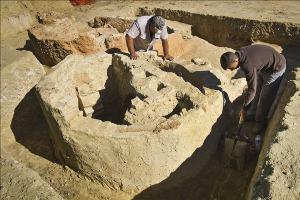Source - http://www.laht.com/article.asp?ArticleId=2355320&CategoryId=12395

The discovery of tell-tale objects during excavations at Palos de la Frontera in southwestern Spain has allowed scholars to determine the exact location from which Christopher Columbus’s three ships set off to discover the New World in 1492.
The discovery is of international importance, as it sheds light on one of the most important chapters of history.
For years it had been suspected that the remains of the port’s long-vanished infrastructure was located in the area known as “the trough,” but until Monday, there was no evidence to confirm it, said Professor Juan Manuel Campos, who led the team that made the discovery.
Historical sources say the port comprised a shipyard, a fresh water fountain called La Fontanilla, a pottery works and a reef, Campos told a press conference.
Traces of the pottery and the reef were discovered in the most recent excavation, confirming Palos as Columbus’ point of departure.
Enrique Martinez Ituno, the Argentine consul to Spain from the early 20th-century, chose Palos de la Fontanilla as his residence, even though he developed his professional career in Malaga. He was passionate about the town and was already advocating the search for and restoration of the historic port in 1908.
In 1992 researchers already deduced, through indirect data, that the port was located somewhere in the area known as the “vaguada,” or trough. But it hasn’t been until now, 24 years later, that archeological excavations led by Campos, professor at the University of Huelva, confirmed the hunch.
The discovery of the pottery has been crucial, since seven ovens have been found that make it a “unique example of this type of building in 15th-century Spain, in which ceramics, bricks, tiles, baked goods and lime were produced.
But the discovery of the reef is of even greater importance, allowing the experts to determine the exact location of the port.
Palos was an “international and prosperous” port from the second half of the 15th-century to the early 16th-century, as these findings attest.
“The reef was the port’s customs area, and it was the place where Columbus negotiated and made the arrangements necessary for the success of his historic voyage,” Campos said, adding that “this is the most satisfying discovery we’ve made.”
A month of excavations still lies ahead, after which awaits a long period of lab work examining the “thousands and thousands of articles” found.
Palos de la Frontera is a “central point” in Columbine research, which, even without the archaeological remains, should be considered “a historic site” in which one of the most important events in world history, Columbus’ discovery of America, started out.
The Palos city council is already planning on a revival of these landmarks, starting with a virtual re-creation that the research team is already working on.